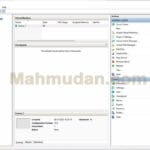This document explains how to create an automatic table of contents in Microsoft Word. Creating an automatic table of contents is quite easy, it only takes a few clicks. But before doing that, You must know four important points in creating an automatic table of contents in Word.
These four important points are interrelated with the automatic table of contents. What are the four important points? What are the advantages of using an automatic table of contents?
This guide article will explain it in detail complete with step by step pictures. You can practice this guide at Word 2010 or a newer version like Word 2016, Word 2019 and Word 2021.
List of contents
Introduction
To be able to create an automatic table of contents in Word, You need to know four important points related to automatic tables of contents in Word. The four important points are:, how to use Heading styles, how to modify Heading style, how to create an automatic table of contents in Word, and how to update the table of contents.
Why applying the Heading style is closely related to the automatic table of contents? With Headings, The Word application can recognize which text is the title, subtitles and sub-subtitles. By applying appropriate heading styles, With this you can also create an automatic table of contents in Word.
From Microsoft Word provided text styles that can be applied to typing. Some of the styles available include Normal, Heading 1, Heading 2, Heading 3 and so on. The default style format may not match your writing format, Therefore, it is also important to know how to modify text styles, especially headings.
Stages of Creating an Automatic Table of Contents in Word
Implementing Headings
In one stroke, often found in the title, subtitle, as well as subtitles, some also use the term chapter, subchapter, and other derivatives. Therefore, before you can create an automatic table of contents in Word, The first step that must be taken is to apply the style Headings to subtitles and sub-subheadings.
For example, the first subudul text is “CHAPTER I INTRODUCTION“. So that Microsoft Word can recognize text “CHAPTER I INTRODUCTION” as a subtitle, you need to apply style Heading 1 for text “CHAPTER I INTRODUCTION”.
Before applying the Heading style, consider modifying the Heading style first

To apply a style Headings on the text, Do the following steps:
- Click on the subtitle text line,
- Then click style Heading 1 which is located in the tabHome partStyle.
- Repeat step number 1 And 2 for any other subtitles as well as styles Heading 2 for each sub-subheading.
After applying the styleHeading 1 on the text “CHAPTER I INTRODUCTION”, then the text format will change according to the style formatHeading 1 built into the Word application.
You will probably see the format Heading 1 does not match the format it should be in, therefore you need modify the Heading style to suit the format you want.
Headings Modification
Modifying the Headings style is changing the font type, colors and other settings for Headings. To modify the Headings style, do the following steps:

- Activate the menu Style by clicking the icon in the lower right corner of the section Style or by pressing a button Alt + Ctrl + Shift + S
- On the menu Style, point the pointer to Heading 1 so that a triangle icon appears then click on the icon.
- Choose Modify to modify the Heading style.
- On display Modify Style, change the text style to match the format you want. You can change the font type, font size, colors and other settings. For example in this guide, for style Heading 1, The format used is text Bold with center alignment, font size 12 or 14. You can determine it yourself according to your needs.

Furthermore, You can choose to apply this newly created format to every new document or only to the document you are currently working on. If you want to apply as default style, choose New document on this template, if not then select it Only this document, then click OK to implement changes.
After modifying Heading 1, You can repeat the steps above to modify Heading 2, Heading 3 and so on.
Should, Modify your Heading style before applying the Heading style, This step is faster and more practical.
Add Automatic Table of Contents
After applying the appropriate Heading style to your typing, You can add an automatic table of contents. Usually, The table of contents is made on a separate page, after the title page.
To create an automatic table of contents on a new page, follow these steps:
- Insert Blank Page.

To insert a blank page, Place the cursor at the beginning of the page then open the tab Insert then click Blank Page.
- Add Automatic Table of Contents

On the newly created blank page, open the tab Referances then click Table of Contents then select Automatic Table of Contents 2
The Word application will automatically create a table of contents based on style Heading that you have applied previously.

Automatically Update Table of Contents
If you have made typing changes that affect the subtitle or page number of the subtitle and/or sub-subhead, You can update the contents of the table of contents by clicking Update Table.

You can also format the style of text in the table of contents just as you would format regular text.
Advantages of Using an Automatic Table of Contents
By using an automatic table of contents, all things related to the table of contents will be created automatically. Besides that, by applying style Heading to type, when you hover the pointer over the subtitle or sub-subhead text, A triangle will appear at the beginning of the text.
When the triangle is clicked, the paragraphs below it will close and open. This action is very helpful in navigating Word documents. With this, it is easier for you to move between subtitles or between sub-subtitles.

Cover
That's how to create an automatic table of contents in Word. Before you can create an automatic table of contents, Four important points must be known first, namely the application of the Heading style, Heading style modification, create an automatic table of contents from Headings and update the content of the automatic table of contents.
By applying the Heading style, typing becomes neater and easier to navigate. The automatic table of contents in Word is created based on the applied Heading style. Using an automatic table of contents in Word makes typing faster and more practical, no more typing subtitles, the sub-sub-county, and page numbers manually.
How? Are there still problems and difficulty in creating an automatic table of contents?? download and use example of an automatic table of contents in Word which we have provided.
Hope it is useful.







